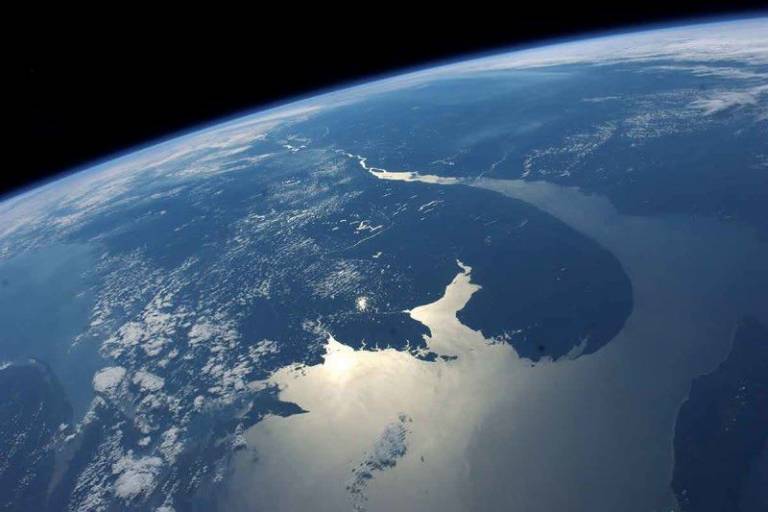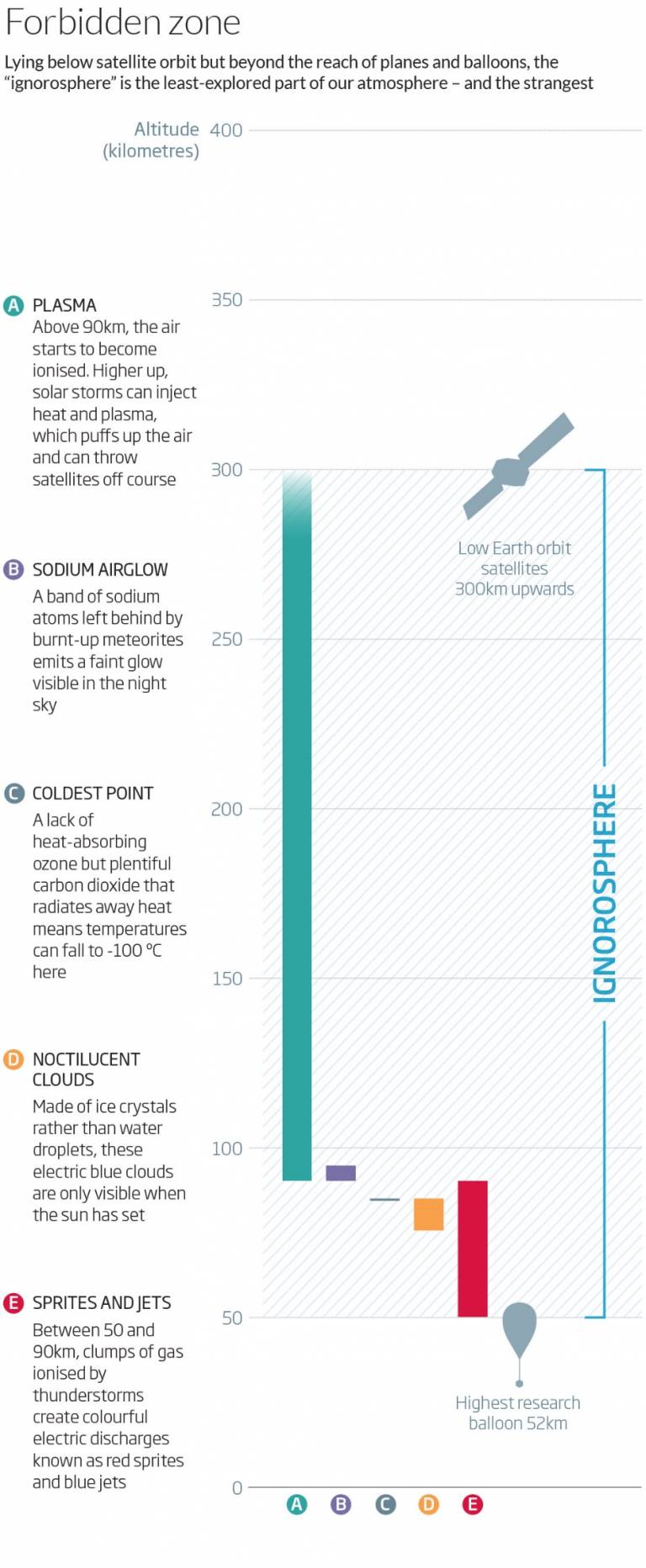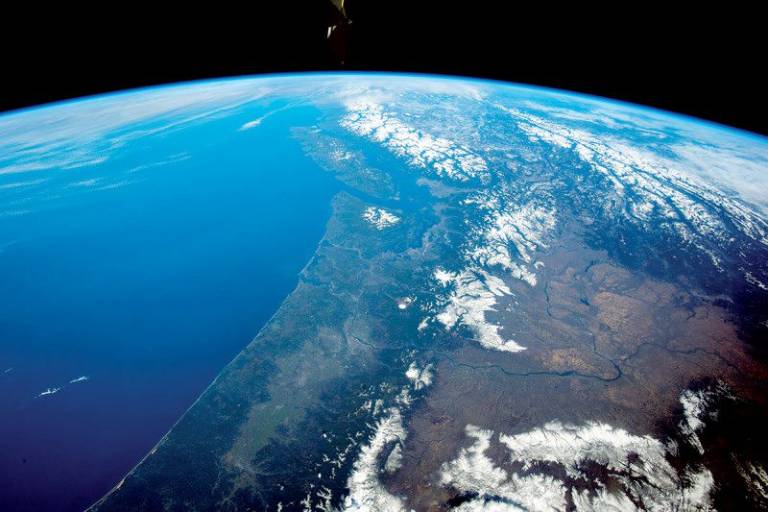New Scientist Air-of-Mystery
25 October 2016

In this forbidden region, planes can't fly, balloons can't float, and satellites struggle to orbit. A swarm of tiny probes is about to reveal its secrets.
A ROBOTIC arm pokes out of the International Space Station, holding a rack of tiny probes. Gently it pushes them out, two or three at a time, to start their fatal spiral down towards Earth.
It may not sound dramatic, but this moment, scheduled for early 2017, will mark a new era in human exploration. The probes will investigate a forbidden zone surrounding our planet. It's a realm where planes can't fly, balloons can't float, and satellites soon plunge to a fiery end. So seldom have we visited it and so scanty is our knowledge of it that some scientists call it the ignorosphere.
This slice of the atmosphere is, at the same time, forbidden and forbidding. It holds both the coldest and the hottest air on Earth. It hosts elusive, shimmering clouds that can only be seen at night. And its moods can change in an instant, as turbulent winds from lower down mix with plasma arriving from the sun.
This unknown zone increasingly matters to us. We are sending up ever more satellites, which are vulnerable to flare-ups in the ignorosphere. Electrical disturbances in this region can scramble GPS signals and other communications. And its influence may even stretch down to ground level and alter our weather. So we need to understand this rarefied air - and to do so, we must go and explore it.
Can we harness the atmosphere? Rain makers: How high-flying bacteria could control the clouds
The ignorosphere encompasses those in-between altitudes that we find extremely hard to navigate. Above about 50 kilometres - where the stratosphere ends - the air becomes too thin to support research balloons. And below 300 km, it is too thick for satellites to survive the drag forces for more than a few months.
Within this zone are two starkly different layers. Lower down is the icy mesosphere, which reaches up to about 100 km. The air here has essentially the same composition as what's in your lungs, but is desperately thin. Even at the base of the mesosphere, the density is just a thousandth that at sea level. Lower down, ozone soaks up ultraviolet radiation to heat the air, but up here very little radiation is absorbed. Meanwhile, carbon dioxide molecules keep radiating infrared heat away, dramatically cooling things down: parts of the mesosphere get to below -100 °C. This layer is also home to some remarkable atmospheric phenomena, such as those mysterious night-shining clouds.
No-fly zone
Above the mesosphere is the thermosphere, heated to thousands of degrees by ultraviolet light. The radiation forces some of the molecules to break down into charged ions. As you go higher, inclement space weather makes itself felt. A solar storm can inject heat and material into the ignorosphere, making it puff up. The result is a plume of gas that is much denser than the air around it - a threat to technology circling in low Earth orbit (see "Save our satellites").
We might be able to avert this and other hazards if we could forecast what the upper atmosphere will do. The trouble is, our models are starved of data. "Our forecasts of how space weather affects the atmosphere are a factor of 2 to 5 off," says space physicist Dhiren Kataria at University College London (UCL).
The few direct measurements we do have are mostly from occasional rocket flights that streak through the ignorosphere in a couple of minutes - hardly enough to paint a full picture of this complex realm. Apart from those, we have some readings taken from ground level. Anasuya Aruliah, also at UCL, uses optical instruments called Fabry-Perot interferometers to trace the faint glow emitted by atomic oxygen: green from a layer around 120 km up, red from around 240 km up. Observing this glow is a valuable glimpse of conditions up there, because its wavelength is affected by temperature and wind speed.
We also have lidar instruments that can measure temperature and composition - though only up to about 90 km - and radar that can probe charged particles in the ignorosphere above 80 km or so.
But coverage is patchy and can give conflicting results. For example, Aruliah has used interferometer data to calculate the density of the thermosphere around 240 km up, but her value was twice that inferred from the re-entry speed of a European Space Agency satellite in 2013. She points out that uncertainty about the total drag on the satellite might explain the discrepancy. Whatever the case, for now we don't know how dense the atmosphere is at this altitude.
"A robotic arm will launch the satellites two or three at a time into oblivion"

Good news, then, that NASA is planning two Earth-observing satellites, known as ICON and GOLD, that will analyse the upper atmosphere. Due to launch in 2018, GOLD will be placed in a geostationary orbit almost 36,000 km up, from where it will be able to look down on and monitor the thermosphere across a wide swathe of the planet. ICON, meanwhile, will concentrate on measuring charged particles. "Continuous coverage is critical," says Hanli Liu at the National Center for Atmospheric Research in Boulder, Colorado - especially given the rapidly changing conditions in the upper atmosphere.
Whereas those missions will look on from afar, another will really take the plunge - and this is where those tiny explorers come in. The QB50 project will see a fleet of CubeSats, each 20 by 10 by 10 centimetres, entering the ignorosphere. "There is huge potential in this technology," says project leader Jan Thoemel, at the von Karman Institute in Sint-Genesius-Rode, Belgium. "With many satellites, you can take measurements simultaneously in many places." They are also cheap, because each CubeSat is built as an educational project by one of 50 university teams from across the globe. Students must follow certain specifications, although there is enough leeway that they can work out their own approaches. That might raise quality-control issues, but Thoemel points out that with 50 of the things, you can accept a few failures.
Watch this: What happens when a Cygnus spacecraft burn up as it re-enters the atmosphere
Most of the CubeSats will be sent to the International Space Station in December. Within a month or so, astronauts will take a batch of 20 to the Japanese science module, Kibo. Its robotic arm will grab a rack of them, manoeuvre into position and then launch them two or three at a time into oblivion.
At their release height of 400 km, the CubeSats will feel only a gentle drag from the thin atmosphere pulling them down. As they descend, the increased drag will mean gravity pulls them down ever faster. It might take a year or two for them to reach 200 km. The plan is to release a second string of CubeSats three months after the first, so the probes gather data at two altitudes simultaneously.
Each CubeSat will carry a sensor. Some will measure the density of neutral atoms and molecules; others will detect ions. To reduce drag and extend their lives, they will try to orient themselves in the direction of orbit using magnetic devices called torquers that can gain a grip on Earth's magnetic field. But once they descend below 200 km, the CubeSats may only have another week left. Thoemel hopes to get data down to perhaps 90 km, where the CubeSats could fly through noctilucent clouds. "But things will be very difficult at this altitude," he says: the hypersonic headwind will make it hard for the CubeSats to maintain their orientation, and they may lose contact with ground stations.
By about 60 km, the little explorers will burn up - all, that is, but one. "Our own von Karman satellite has a thermal protection system," says Thoemel. "It should survive and take measurements during the hot re-entry phase."

The data from QB50 should help improve predictions of how the thermosphere can snag satellites, as well as refining real-time models of the upper atmosphere used for forecasting. More speculatively, QB50 might shed light on any effect that the turbulent ignorosphere may be having on our weather below.
That it has any such effect is hardly an accepted idea, but there have been recent hints that high and low are more intimately linked than we realised. For example, simulations suggest that convection currents rooted in tropical thunderstorms can cause bulges in the thermosphere.
Meanwhile, NASA's AIM satellite has been monitoring noctilucent clouds, and has found that they are surprisingly in thrall to ground-level temperatures on the other side of the planet. If it turns mild in the northern hemisphere winter, then a couple of weeks later there are more noctilucent clouds in Antarctica. No one knows what causes that link. "But one of the really new things we're finding is how connected the different regions of the atmosphere really are," says Cora Randall at the University of Colorado in Boulder.
Whether influences also run in the opposite direction, from high to low, is controversial. After all, the ignorosphere is insubstantial compared with our thick terrestrial air. Could it really have much of an effect on us? "Lower-atmosphere researchers have a prejudice that the upper atmosphere doesn't matter - that 'the tail can't wag the dog'," says Aruliah.
Ignore no more
When weather models have been extended upwards in the past, forecasts have improved, says David Jackson, who manages space weather research at the UK's Met Office in Exeter. Around 15 years ago, the organisation extended the altitude limit of its models from 30 to 60 km, which increased long-term accuracy, he says.
If the stratosphere matters to weather, how about the ignorosphere above it? There are a few ideas about how it might have an influence, despite the thinness. One is to do with nitric oxide. This is created in the ignorosphere above the poles by energetic particles from the sun, and winds can carry it around the world. Some of it may reach lower levels, where it can destroy ozone. That, in turn, would affect the climate because ozone is a greenhouse gas.
Gravity waves could provide a more powerful downward link. These are waves in the atmosphere's gas, akin to those in water, and can be created in the ionosphere when the solar wind's magnetic field changes direction. According to theoretical work by Paul Prikryl and his team at Canada's Communications Research Centre in Ottawa, these waves could indirectly generate bands of cloud and boost the strength of cyclones.
Jackson is now working on a new whole-atmosphere model that extends right up to 500 km in the thermosphere. His main aim is to understand space weather and its effects on satellites, but the model could also show us whether the wispy air of the ignorosphere can really change ground-level weather. "The QB50 data will be very important in validating this model," he says.
Could QB50 be the forerunner of a bigger scientific presence in the ignorosphere? "Eventually, I think CubeSats could be used like weather balloons, with a swarm perhaps every six months," says Aruliah. If that does come to pass, it'll be the ignorosphere no more. We'll need a new name for what used to be the atmosphere's last unexplored realm.
Save our Satellites
The elegant dance of the polar aurora attracts legions of tourists every year, but for some the display is not so pretty.
The solar storms that create the aurora inject heat and ionised plasma into the upper atmosphere, causing it to puff up and thus increase the drag on satellites in low Earth orbit. Sometimes this is so sudden that space agencies can lose track of their expensive property. "After intense solar activity, NASA has lost hundreds of satellites," says Jan Thoemel at the von Karman Institute in Sint-Genesius-Rode, Belgium.
Even small solar storms can throw their trajectories off a little. That's no mere inconvenience: the ISS and other satellites must already navigate with care to avoid space junk, and collisions will become more of a risk as low Earth orbit gets more crowded.
As well as posing a hazard to satellites themselves, sudden changes in atmospheric ionisation can deflect their radio signals en route to Earth. The culprit might be a solar storm or violent weather down below. "This region has two masters: the sun and the weather," says Cathryn Mitchell of the University of Bath, UK. "We're never quite sure which is in charge."
During the major solar storm of October 2003, GPS positions were thrown off by hundreds of metres. Such events can have serious repercussions today. "Loads of our infrastructure relies on GPS for positioning or timing," says Mitchell. Your car's satnav might be able to cope with some errors, but aircraft, shipping and military operations all rely on precise positioning. GPS-based timing is also used to ensure financial trading is synchronised and fair.
Mitchell uses computer models to "nowcast" the upper atmosphere, helping correct for glitches in real time. But it's a highly inexact science - until we understand the upper atmosphere, that is (see main story).
This article appeared in print under the headline "Air of mystery"
New Scientist feature article 17 August 2016
 Close
Close

